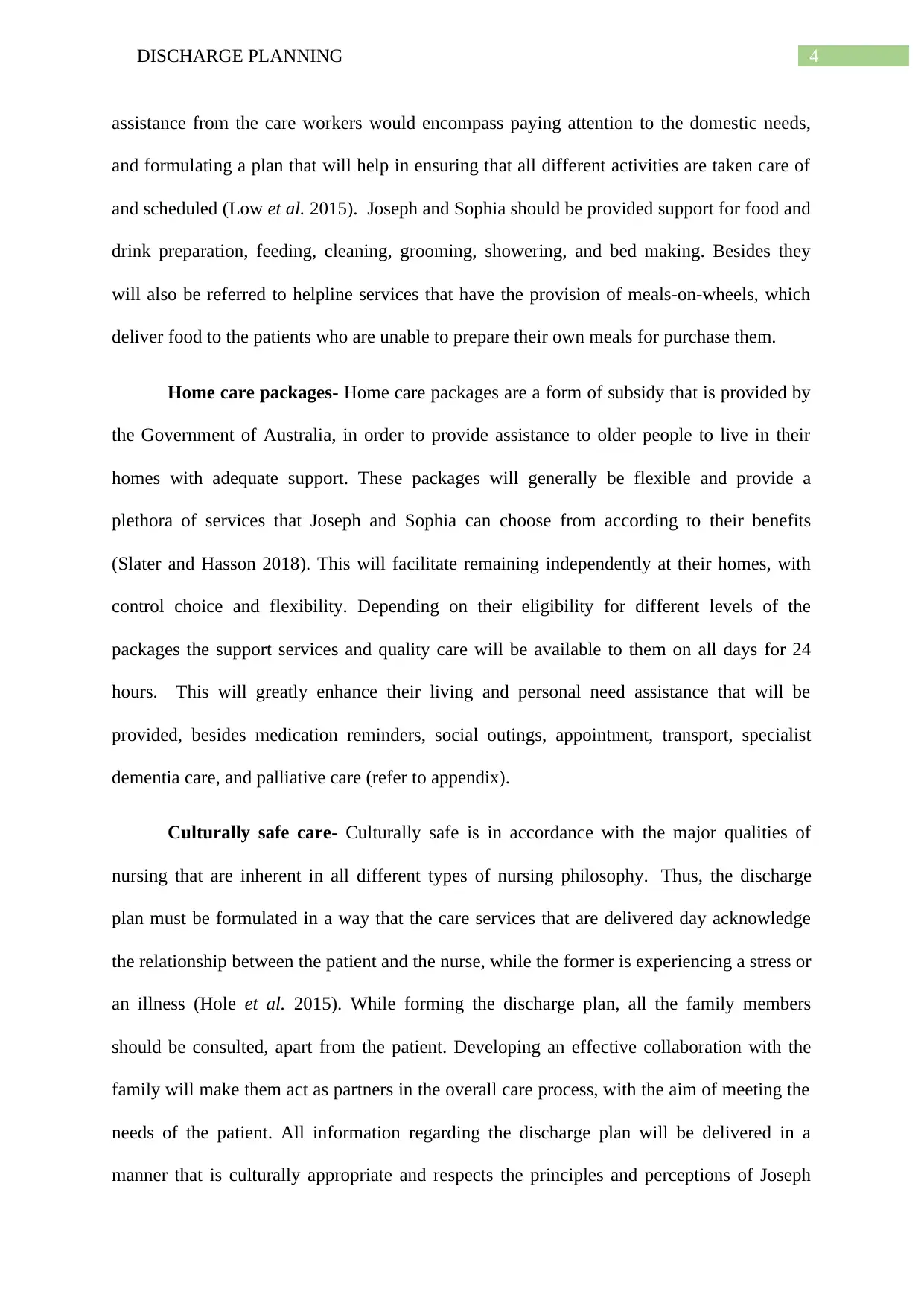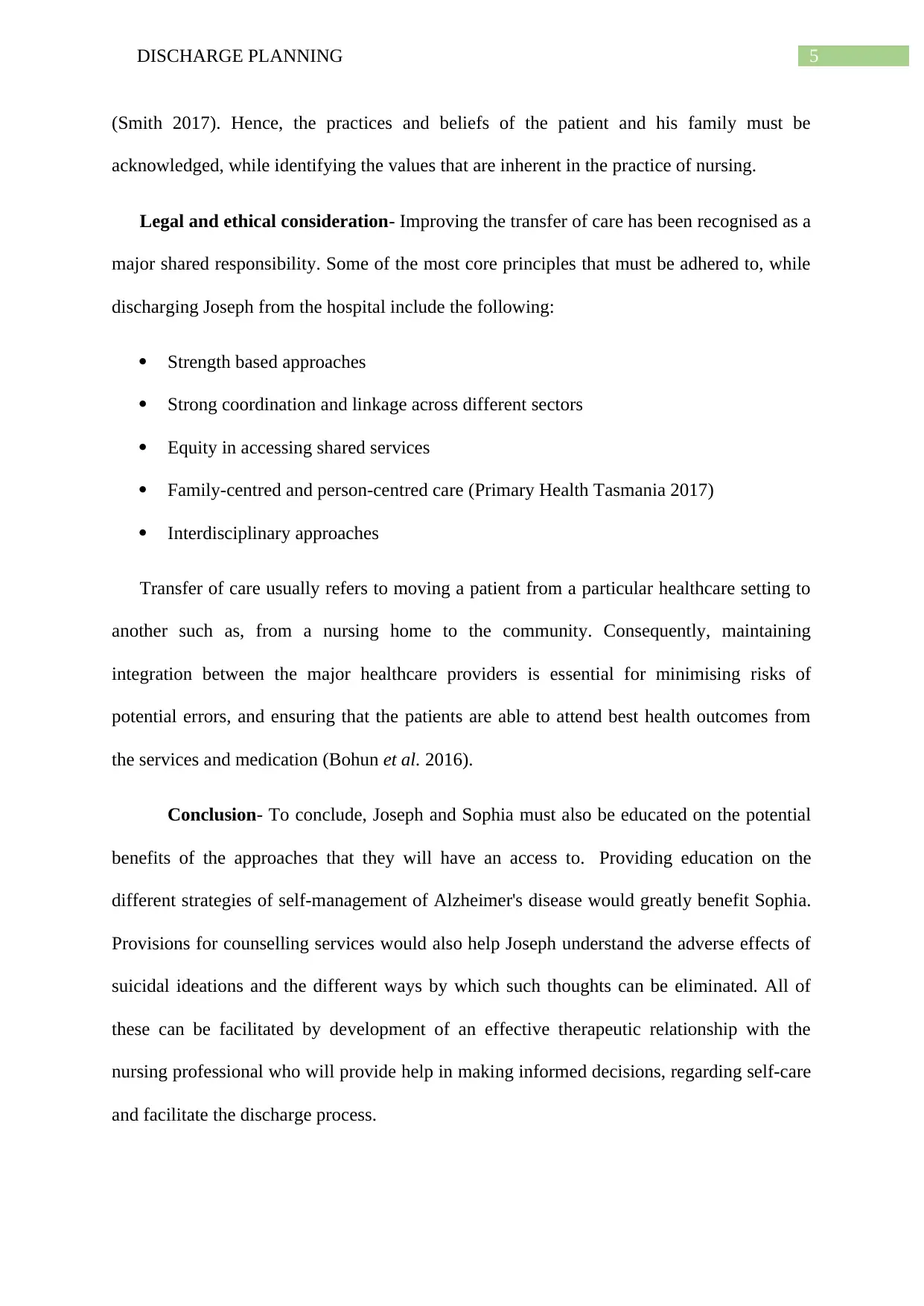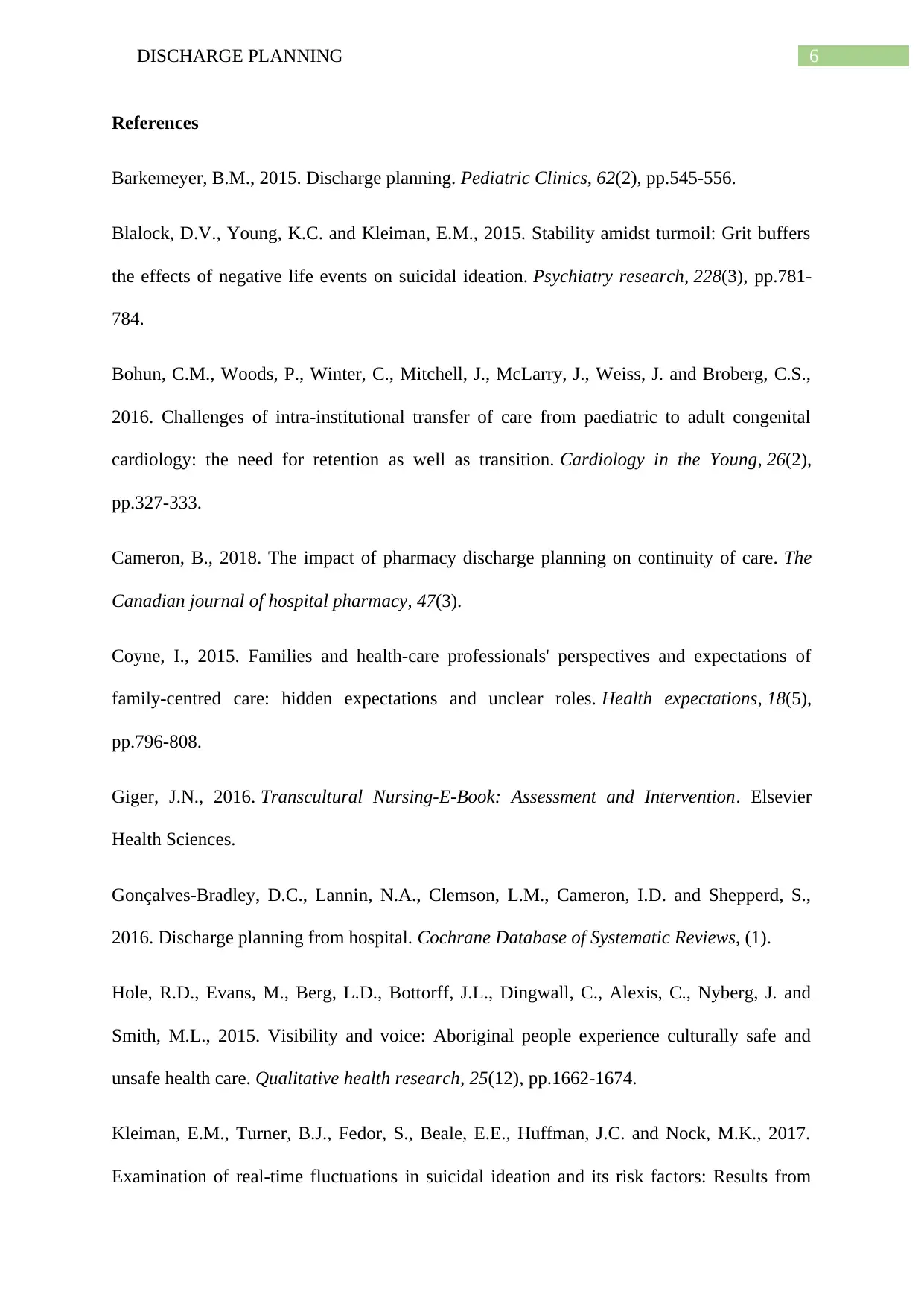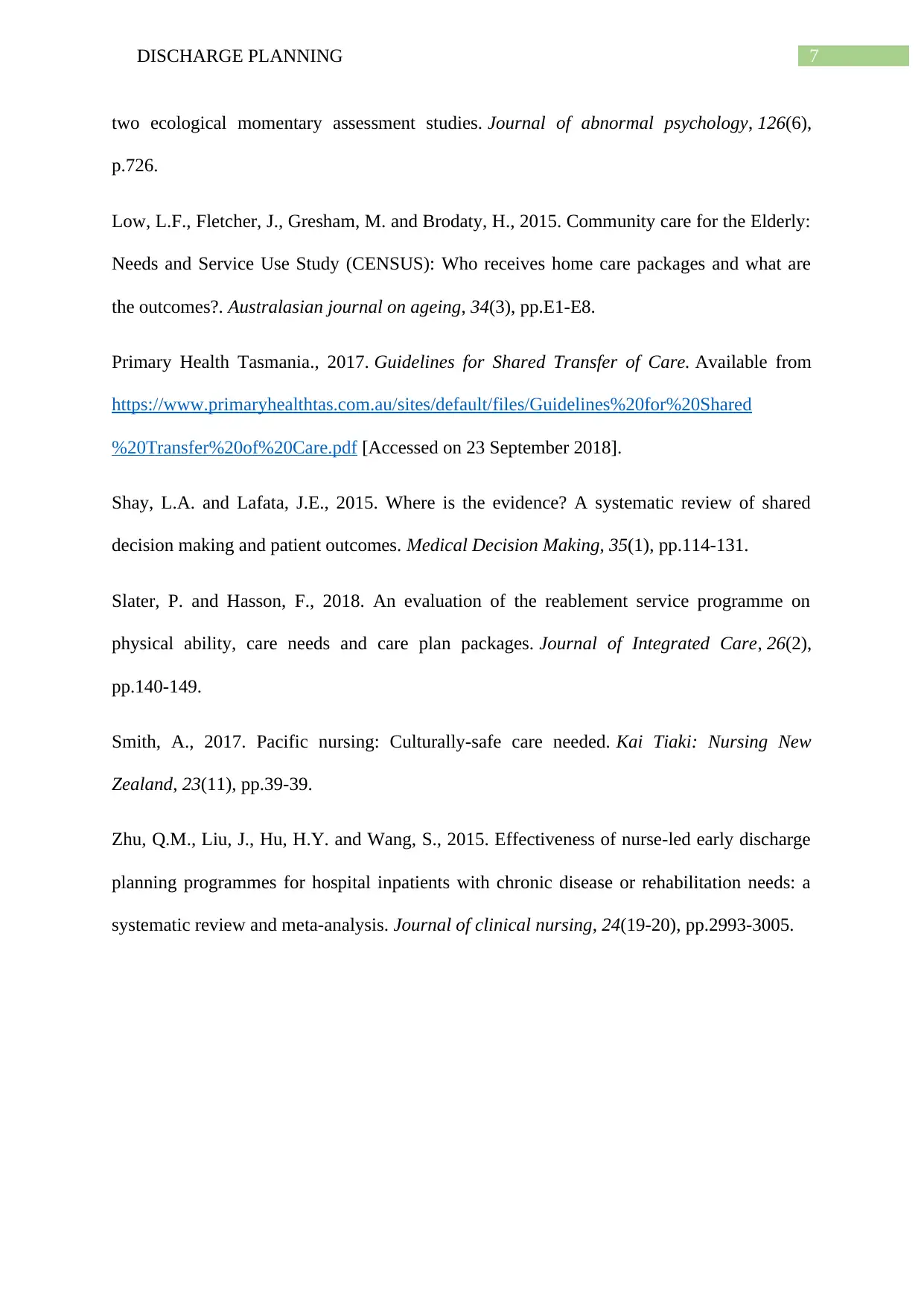Discharge Planning Report: Joseph's Case, Action Plan and Wellbeing
VerifiedAdded on 2020/05/16
|10
|2446
|362
Report
AI Summary
This report presents a discharge plan for Joseph, a 55-year-old man of Australian descent, who attempted suicide due to stress related to his wife Sophia's Alzheimer's disease, financial strain, and estrangement from his son. The report details Joseph's medical stability and the need for culturally safe care, considering his family's values and beliefs. It outlines nursing assessments, information processing, and the identification of key problems, including ensuring the health and safety of both Joseph and Sophia. The discharge plan emphasizes domestic support, home care packages, and culturally safe care practices, including legal and ethical considerations. The report highlights the importance of family involvement, interdisciplinary approaches, and providing education on self-management strategies for Alzheimer's and counseling services for Joseph. The goal is to promote continuity of care and improve their overall wellbeing.

Running head: DISCHARGE PLANNING
Case report
Name of the Student
Name of the University
Author Note
Case report
Name of the Student
Name of the University
Author Note
Paraphrase This Document
Need a fresh take? Get an instant paraphrase of this document with our AI Paraphraser

1DISCHARGE PLANNING
Introduction- Discharge planning refers to a procedure that helps in bringing about
an improvement in healthcare service coordination, following discharge of a patient from a
hospital. It takes into account the needs of the patient, in the community in which he/she
resides (Gonçalves‐Bradley et al. 2016). The primary purpose of discharge planning is
ensuring presence of continuity in the care quality between the community and the hospital.
In other words, the objective of discharge planning is reduction of the length of
hospitalization and readmissions to hospital, besides enhancing coordination of care services
(Cameron 2018). The assignment will elaborate on the discharge plan of Joseph and
formulate a culturally safe care and formulate an action plan for enhancing his optimal health
and wellbeing.
Considering patient information- Joseph is a 55 year old man of Australian descent
who had been admitted to the Hospital’s emergency department following carbon monoxide
poisoning due to a failed suicidal attempt. Joseph used for care for his wife Sophia (who has
been diagnosed with Alzheimer’s disease, prior to his admission. He has been found to be
medically stable and is soon to be discharged from the hospital.
Collecting cues- Joseph had migrated to Australia along with his wife Sophia 35
years ago. He usually described his life as perfect and well supported his family. Upon
arriving in Australia, Joseph and Sophia became parents to a boy, and were able to
successfully establish their business as well. However, some of the most significant events
that resulted in the suicidal attempt by Joseph included loss of contact with their son Robert,
following his relocation to the United States for pursuing higher education, huge financial
loss, and stress in providing care to Sophia and her progressing dementia. It was perceived by
Joseph that caring for Sophia was his utmost responsibility but he was unable to do so, owing
to the progressing old age and lack of support from his child. Despite repeated attempts by
their son in admitting Joseph and Sophia to respite care services that deliver short term care
Introduction- Discharge planning refers to a procedure that helps in bringing about
an improvement in healthcare service coordination, following discharge of a patient from a
hospital. It takes into account the needs of the patient, in the community in which he/she
resides (Gonçalves‐Bradley et al. 2016). The primary purpose of discharge planning is
ensuring presence of continuity in the care quality between the community and the hospital.
In other words, the objective of discharge planning is reduction of the length of
hospitalization and readmissions to hospital, besides enhancing coordination of care services
(Cameron 2018). The assignment will elaborate on the discharge plan of Joseph and
formulate a culturally safe care and formulate an action plan for enhancing his optimal health
and wellbeing.
Considering patient information- Joseph is a 55 year old man of Australian descent
who had been admitted to the Hospital’s emergency department following carbon monoxide
poisoning due to a failed suicidal attempt. Joseph used for care for his wife Sophia (who has
been diagnosed with Alzheimer’s disease, prior to his admission. He has been found to be
medically stable and is soon to be discharged from the hospital.
Collecting cues- Joseph had migrated to Australia along with his wife Sophia 35
years ago. He usually described his life as perfect and well supported his family. Upon
arriving in Australia, Joseph and Sophia became parents to a boy, and were able to
successfully establish their business as well. However, some of the most significant events
that resulted in the suicidal attempt by Joseph included loss of contact with their son Robert,
following his relocation to the United States for pursuing higher education, huge financial
loss, and stress in providing care to Sophia and her progressing dementia. It was perceived by
Joseph that caring for Sophia was his utmost responsibility but he was unable to do so, owing
to the progressing old age and lack of support from his child. Despite repeated attempts by
their son in admitting Joseph and Sophia to respite care services that deliver short term care

2DISCHARGE PLANNING
for extremely sick or old people, they expressed disapproval at getting admitted to such
services.
Gathering information- Some of the most essential nursing assessments that must be
conducted in Joseph in order to assess is overall health status encompass cultural, physical,
spiritual, family, and mental health. Taking into account family health will also help in
unravelling the different beliefs and values that are shared by all family members (Giger
2016). This can be facilitated by promoting a discussion with Sophia, and their son, while
Joseph provides his consent for the same. Nursing assessment is not any specific test but
comprises of a collection of information regarding the psychological, sociological,
physiological, and spiritual status of a particular person. Hence, conducting a nursing
assessment that would include his family members would necessarily form the first step of
information gathering. The nursing assessment for also vital to discharge planning, due to the
fact that discharging a patient from a healthcare setting is controlled by different social,
external, and cultural issues that might create an impact on the overall health and quality of
well being of the service user (Zhu et al. 2015). The first and foremost step during discharge
planning would be to establish a contact with the general practitioners who had evaluated
Joseph.
Processing information- Suicidal thoughts refer to having or thinking about unusual
preoccupations, related to suicide, and they range from extensive to fleeting thoughts with
detailed planning, incomplete attempts, and role playing (Kleiman et al. 2017). Research
evidences have elaborated on the fact that there are a range of negative life events of sudden
life changeover that are responsible for bringing about a persistent state of distress and agony
in the life of the sufferers, which in turn promotes them to attempt suicide (Blalock, Young
and Kleiman 2015). Some of the major factors that might have played an essential role in the
for extremely sick or old people, they expressed disapproval at getting admitted to such
services.
Gathering information- Some of the most essential nursing assessments that must be
conducted in Joseph in order to assess is overall health status encompass cultural, physical,
spiritual, family, and mental health. Taking into account family health will also help in
unravelling the different beliefs and values that are shared by all family members (Giger
2016). This can be facilitated by promoting a discussion with Sophia, and their son, while
Joseph provides his consent for the same. Nursing assessment is not any specific test but
comprises of a collection of information regarding the psychological, sociological,
physiological, and spiritual status of a particular person. Hence, conducting a nursing
assessment that would include his family members would necessarily form the first step of
information gathering. The nursing assessment for also vital to discharge planning, due to the
fact that discharging a patient from a healthcare setting is controlled by different social,
external, and cultural issues that might create an impact on the overall health and quality of
well being of the service user (Zhu et al. 2015). The first and foremost step during discharge
planning would be to establish a contact with the general practitioners who had evaluated
Joseph.
Processing information- Suicidal thoughts refer to having or thinking about unusual
preoccupations, related to suicide, and they range from extensive to fleeting thoughts with
detailed planning, incomplete attempts, and role playing (Kleiman et al. 2017). Research
evidences have elaborated on the fact that there are a range of negative life events of sudden
life changeover that are responsible for bringing about a persistent state of distress and agony
in the life of the sufferers, which in turn promotes them to attempt suicide (Blalock, Young
and Kleiman 2015). Some of the major factors that might have played an essential role in the
⊘ This is a preview!⊘
Do you want full access?
Subscribe today to unlock all pages.

Trusted by 1+ million students worldwide

3DISCHARGE PLANNING
failed suicidal attempt are the sudden financial strain, distant relationship with son, increase
in age, and poor health status of both self and his wife Sophia.
Identifying the problem- The primary objective of the discharge planning process
should be directed towards ensuring the health and safety of both Joseph and Sophia, and
facilitating recovery from the present condition (Barkemeyer 2015). Taking into
consideration the fact that Sophia was being given care by her husband, prior to his admission
at the emergency department, her progressing Alzheimer's disease should also be addressed
adequately, while planning the discharge. Promoting effective ongoing treatment that is in
accordance with their cultural values and beliefs will help in enhancing their quality of life.
Adopting a non-judgmental approach towards treating the presenting complaints will also
prove beneficial in establishment of positive health outcomes (Shay and Lafata 2015).
Discharge planning- Research articles have elaborated on the fact that often there is
a lack of congruence that exists between the preferences of the patients and their care give us,
which in turn calls for the need of assessing the preferences of both the service user and their
family members, during the early steps of discharge planning (Coyne 2015). Incorporating
their demands and wants in the discharge planning process has been found beneficial in
improving effectiveness of the care that is being given, enhancing overall health status.
Therefore, involving the patient, his peers, and immediate family members during the
planning process will help in gaining a sound understanding of the concerns, observations,
and preferences. This will help in accomplishing the primary goal of maintaining continuity
in the quality of care between the community and the hospital.
Domestic support and personal care- Domestic support care has been found
imperative in cases where the activities of daily living and general domestic duties are
difficult to cope with, and the patients are unable to conduct them independently. Hence,
failed suicidal attempt are the sudden financial strain, distant relationship with son, increase
in age, and poor health status of both self and his wife Sophia.
Identifying the problem- The primary objective of the discharge planning process
should be directed towards ensuring the health and safety of both Joseph and Sophia, and
facilitating recovery from the present condition (Barkemeyer 2015). Taking into
consideration the fact that Sophia was being given care by her husband, prior to his admission
at the emergency department, her progressing Alzheimer's disease should also be addressed
adequately, while planning the discharge. Promoting effective ongoing treatment that is in
accordance with their cultural values and beliefs will help in enhancing their quality of life.
Adopting a non-judgmental approach towards treating the presenting complaints will also
prove beneficial in establishment of positive health outcomes (Shay and Lafata 2015).
Discharge planning- Research articles have elaborated on the fact that often there is
a lack of congruence that exists between the preferences of the patients and their care give us,
which in turn calls for the need of assessing the preferences of both the service user and their
family members, during the early steps of discharge planning (Coyne 2015). Incorporating
their demands and wants in the discharge planning process has been found beneficial in
improving effectiveness of the care that is being given, enhancing overall health status.
Therefore, involving the patient, his peers, and immediate family members during the
planning process will help in gaining a sound understanding of the concerns, observations,
and preferences. This will help in accomplishing the primary goal of maintaining continuity
in the quality of care between the community and the hospital.
Domestic support and personal care- Domestic support care has been found
imperative in cases where the activities of daily living and general domestic duties are
difficult to cope with, and the patients are unable to conduct them independently. Hence,
Paraphrase This Document
Need a fresh take? Get an instant paraphrase of this document with our AI Paraphraser

4DISCHARGE PLANNING
assistance from the care workers would encompass paying attention to the domestic needs,
and formulating a plan that will help in ensuring that all different activities are taken care of
and scheduled (Low et al. 2015). Joseph and Sophia should be provided support for food and
drink preparation, feeding, cleaning, grooming, showering, and bed making. Besides they
will also be referred to helpline services that have the provision of meals-on-wheels, which
deliver food to the patients who are unable to prepare their own meals for purchase them.
Home care packages- Home care packages are a form of subsidy that is provided by
the Government of Australia, in order to provide assistance to older people to live in their
homes with adequate support. These packages will generally be flexible and provide a
plethora of services that Joseph and Sophia can choose from according to their benefits
(Slater and Hasson 2018). This will facilitate remaining independently at their homes, with
control choice and flexibility. Depending on their eligibility for different levels of the
packages the support services and quality care will be available to them on all days for 24
hours. This will greatly enhance their living and personal need assistance that will be
provided, besides medication reminders, social outings, appointment, transport, specialist
dementia care, and palliative care (refer to appendix).
Culturally safe care- Culturally safe is in accordance with the major qualities of
nursing that are inherent in all different types of nursing philosophy. Thus, the discharge
plan must be formulated in a way that the care services that are delivered day acknowledge
the relationship between the patient and the nurse, while the former is experiencing a stress or
an illness (Hole et al. 2015). While forming the discharge plan, all the family members
should be consulted, apart from the patient. Developing an effective collaboration with the
family will make them act as partners in the overall care process, with the aim of meeting the
needs of the patient. All information regarding the discharge plan will be delivered in a
manner that is culturally appropriate and respects the principles and perceptions of Joseph
assistance from the care workers would encompass paying attention to the domestic needs,
and formulating a plan that will help in ensuring that all different activities are taken care of
and scheduled (Low et al. 2015). Joseph and Sophia should be provided support for food and
drink preparation, feeding, cleaning, grooming, showering, and bed making. Besides they
will also be referred to helpline services that have the provision of meals-on-wheels, which
deliver food to the patients who are unable to prepare their own meals for purchase them.
Home care packages- Home care packages are a form of subsidy that is provided by
the Government of Australia, in order to provide assistance to older people to live in their
homes with adequate support. These packages will generally be flexible and provide a
plethora of services that Joseph and Sophia can choose from according to their benefits
(Slater and Hasson 2018). This will facilitate remaining independently at their homes, with
control choice and flexibility. Depending on their eligibility for different levels of the
packages the support services and quality care will be available to them on all days for 24
hours. This will greatly enhance their living and personal need assistance that will be
provided, besides medication reminders, social outings, appointment, transport, specialist
dementia care, and palliative care (refer to appendix).
Culturally safe care- Culturally safe is in accordance with the major qualities of
nursing that are inherent in all different types of nursing philosophy. Thus, the discharge
plan must be formulated in a way that the care services that are delivered day acknowledge
the relationship between the patient and the nurse, while the former is experiencing a stress or
an illness (Hole et al. 2015). While forming the discharge plan, all the family members
should be consulted, apart from the patient. Developing an effective collaboration with the
family will make them act as partners in the overall care process, with the aim of meeting the
needs of the patient. All information regarding the discharge plan will be delivered in a
manner that is culturally appropriate and respects the principles and perceptions of Joseph

5DISCHARGE PLANNING
(Smith 2017). Hence, the practices and beliefs of the patient and his family must be
acknowledged, while identifying the values that are inherent in the practice of nursing.
Legal and ethical consideration- Improving the transfer of care has been recognised as a
major shared responsibility. Some of the most core principles that must be adhered to, while
discharging Joseph from the hospital include the following:
Strength based approaches
Strong coordination and linkage across different sectors
Equity in accessing shared services
Family-centred and person-centred care (Primary Health Tasmania 2017)
Interdisciplinary approaches
Transfer of care usually refers to moving a patient from a particular healthcare setting to
another such as, from a nursing home to the community. Consequently, maintaining
integration between the major healthcare providers is essential for minimising risks of
potential errors, and ensuring that the patients are able to attend best health outcomes from
the services and medication (Bohun et al. 2016).
Conclusion- To conclude, Joseph and Sophia must also be educated on the potential
benefits of the approaches that they will have an access to. Providing education on the
different strategies of self-management of Alzheimer's disease would greatly benefit Sophia.
Provisions for counselling services would also help Joseph understand the adverse effects of
suicidal ideations and the different ways by which such thoughts can be eliminated. All of
these can be facilitated by development of an effective therapeutic relationship with the
nursing professional who will provide help in making informed decisions, regarding self-care
and facilitate the discharge process.
(Smith 2017). Hence, the practices and beliefs of the patient and his family must be
acknowledged, while identifying the values that are inherent in the practice of nursing.
Legal and ethical consideration- Improving the transfer of care has been recognised as a
major shared responsibility. Some of the most core principles that must be adhered to, while
discharging Joseph from the hospital include the following:
Strength based approaches
Strong coordination and linkage across different sectors
Equity in accessing shared services
Family-centred and person-centred care (Primary Health Tasmania 2017)
Interdisciplinary approaches
Transfer of care usually refers to moving a patient from a particular healthcare setting to
another such as, from a nursing home to the community. Consequently, maintaining
integration between the major healthcare providers is essential for minimising risks of
potential errors, and ensuring that the patients are able to attend best health outcomes from
the services and medication (Bohun et al. 2016).
Conclusion- To conclude, Joseph and Sophia must also be educated on the potential
benefits of the approaches that they will have an access to. Providing education on the
different strategies of self-management of Alzheimer's disease would greatly benefit Sophia.
Provisions for counselling services would also help Joseph understand the adverse effects of
suicidal ideations and the different ways by which such thoughts can be eliminated. All of
these can be facilitated by development of an effective therapeutic relationship with the
nursing professional who will provide help in making informed decisions, regarding self-care
and facilitate the discharge process.
⊘ This is a preview!⊘
Do you want full access?
Subscribe today to unlock all pages.

Trusted by 1+ million students worldwide

6DISCHARGE PLANNING
References
Barkemeyer, B.M., 2015. Discharge planning. Pediatric Clinics, 62(2), pp.545-556.
Blalock, D.V., Young, K.C. and Kleiman, E.M., 2015. Stability amidst turmoil: Grit buffers
the effects of negative life events on suicidal ideation. Psychiatry research, 228(3), pp.781-
784.
Bohun, C.M., Woods, P., Winter, C., Mitchell, J., McLarry, J., Weiss, J. and Broberg, C.S.,
2016. Challenges of intra-institutional transfer of care from paediatric to adult congenital
cardiology: the need for retention as well as transition. Cardiology in the Young, 26(2),
pp.327-333.
Cameron, B., 2018. The impact of pharmacy discharge planning on continuity of care. The
Canadian journal of hospital pharmacy, 47(3).
Coyne, I., 2015. Families and health‐care professionals' perspectives and expectations of
family‐centred care: hidden expectations and unclear roles. Health expectations, 18(5),
pp.796-808.
Giger, J.N., 2016. Transcultural Nursing-E-Book: Assessment and Intervention. Elsevier
Health Sciences.
Gonçalves‐Bradley, D.C., Lannin, N.A., Clemson, L.M., Cameron, I.D. and Shepperd, S.,
2016. Discharge planning from hospital. Cochrane Database of Systematic Reviews, (1).
Hole, R.D., Evans, M., Berg, L.D., Bottorff, J.L., Dingwall, C., Alexis, C., Nyberg, J. and
Smith, M.L., 2015. Visibility and voice: Aboriginal people experience culturally safe and
unsafe health care. Qualitative health research, 25(12), pp.1662-1674.
Kleiman, E.M., Turner, B.J., Fedor, S., Beale, E.E., Huffman, J.C. and Nock, M.K., 2017.
Examination of real-time fluctuations in suicidal ideation and its risk factors: Results from
References
Barkemeyer, B.M., 2015. Discharge planning. Pediatric Clinics, 62(2), pp.545-556.
Blalock, D.V., Young, K.C. and Kleiman, E.M., 2015. Stability amidst turmoil: Grit buffers
the effects of negative life events on suicidal ideation. Psychiatry research, 228(3), pp.781-
784.
Bohun, C.M., Woods, P., Winter, C., Mitchell, J., McLarry, J., Weiss, J. and Broberg, C.S.,
2016. Challenges of intra-institutional transfer of care from paediatric to adult congenital
cardiology: the need for retention as well as transition. Cardiology in the Young, 26(2),
pp.327-333.
Cameron, B., 2018. The impact of pharmacy discharge planning on continuity of care. The
Canadian journal of hospital pharmacy, 47(3).
Coyne, I., 2015. Families and health‐care professionals' perspectives and expectations of
family‐centred care: hidden expectations and unclear roles. Health expectations, 18(5),
pp.796-808.
Giger, J.N., 2016. Transcultural Nursing-E-Book: Assessment and Intervention. Elsevier
Health Sciences.
Gonçalves‐Bradley, D.C., Lannin, N.A., Clemson, L.M., Cameron, I.D. and Shepperd, S.,
2016. Discharge planning from hospital. Cochrane Database of Systematic Reviews, (1).
Hole, R.D., Evans, M., Berg, L.D., Bottorff, J.L., Dingwall, C., Alexis, C., Nyberg, J. and
Smith, M.L., 2015. Visibility and voice: Aboriginal people experience culturally safe and
unsafe health care. Qualitative health research, 25(12), pp.1662-1674.
Kleiman, E.M., Turner, B.J., Fedor, S., Beale, E.E., Huffman, J.C. and Nock, M.K., 2017.
Examination of real-time fluctuations in suicidal ideation and its risk factors: Results from
Paraphrase This Document
Need a fresh take? Get an instant paraphrase of this document with our AI Paraphraser

7DISCHARGE PLANNING
two ecological momentary assessment studies. Journal of abnormal psychology, 126(6),
p.726.
Low, L.F., Fletcher, J., Gresham, M. and Brodaty, H., 2015. Community care for the Elderly:
Needs and Service Use Study (CENSUS): Who receives home care packages and what are
the outcomes?. Australasian journal on ageing, 34(3), pp.E1-E8.
Primary Health Tasmania., 2017. Guidelines for Shared Transfer of Care. Available from
https://www.primaryhealthtas.com.au/sites/default/files/Guidelines%20for%20Shared
%20Transfer%20of%20Care.pdf [Accessed on 23 September 2018].
Shay, L.A. and Lafata, J.E., 2015. Where is the evidence? A systematic review of shared
decision making and patient outcomes. Medical Decision Making, 35(1), pp.114-131.
Slater, P. and Hasson, F., 2018. An evaluation of the reablement service programme on
physical ability, care needs and care plan packages. Journal of Integrated Care, 26(2),
pp.140-149.
Smith, A., 2017. Pacific nursing: Culturally-safe care needed. Kai Tiaki: Nursing New
Zealand, 23(11), pp.39-39.
Zhu, Q.M., Liu, J., Hu, H.Y. and Wang, S., 2015. Effectiveness of nurse‐led early discharge
planning programmes for hospital inpatients with chronic disease or rehabilitation needs: a
systematic review and meta‐analysis. Journal of clinical nursing, 24(19-20), pp.2993-3005.
two ecological momentary assessment studies. Journal of abnormal psychology, 126(6),
p.726.
Low, L.F., Fletcher, J., Gresham, M. and Brodaty, H., 2015. Community care for the Elderly:
Needs and Service Use Study (CENSUS): Who receives home care packages and what are
the outcomes?. Australasian journal on ageing, 34(3), pp.E1-E8.
Primary Health Tasmania., 2017. Guidelines for Shared Transfer of Care. Available from
https://www.primaryhealthtas.com.au/sites/default/files/Guidelines%20for%20Shared
%20Transfer%20of%20Care.pdf [Accessed on 23 September 2018].
Shay, L.A. and Lafata, J.E., 2015. Where is the evidence? A systematic review of shared
decision making and patient outcomes. Medical Decision Making, 35(1), pp.114-131.
Slater, P. and Hasson, F., 2018. An evaluation of the reablement service programme on
physical ability, care needs and care plan packages. Journal of Integrated Care, 26(2),
pp.140-149.
Smith, A., 2017. Pacific nursing: Culturally-safe care needed. Kai Tiaki: Nursing New
Zealand, 23(11), pp.39-39.
Zhu, Q.M., Liu, J., Hu, H.Y. and Wang, S., 2015. Effectiveness of nurse‐led early discharge
planning programmes for hospital inpatients with chronic disease or rehabilitation needs: a
systematic review and meta‐analysis. Journal of clinical nursing, 24(19-20), pp.2993-3005.

8DISCHARGE PLANNING
Appendix
Service Target audience Location Benefits Cost
My Care Solution
(Level 1)
Older people Norwood SA Family owned and
provides high
quality care
services to older
people at their
homes
$10.43/day
$146.02/fortnight
Listening Heart
Counselling
Services
Psychologically
distressed
Rose Park Professional,
caring and
confidential
support provided
-
Meals on Wheels
(SA) Inc.
All people Orange Lane Assists in
independent living
$4.90 each
Appendix
Service Target audience Location Benefits Cost
My Care Solution
(Level 1)
Older people Norwood SA Family owned and
provides high
quality care
services to older
people at their
homes
$10.43/day
$146.02/fortnight
Listening Heart
Counselling
Services
Psychologically
distressed
Rose Park Professional,
caring and
confidential
support provided
-
Meals on Wheels
(SA) Inc.
All people Orange Lane Assists in
independent living
$4.90 each
⊘ This is a preview!⊘
Do you want full access?
Subscribe today to unlock all pages.

Trusted by 1+ million students worldwide

9DISCHARGE PLANNING
1 out of 10
Related Documents
Your All-in-One AI-Powered Toolkit for Academic Success.
+13062052269
info@desklib.com
Available 24*7 on WhatsApp / Email
![[object Object]](/_next/static/media/star-bottom.7253800d.svg)
Unlock your academic potential
Copyright © 2020–2025 A2Z Services. All Rights Reserved. Developed and managed by ZUCOL.





